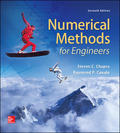
Concept explainers
One of your colleagues has designed a new transdermal patch to deliver insulin through the skin to diabetic patients in a controlled way, eliminating the need for painful injections. She hascollected the following data on the mass flux of insulin being delivered through the patch (and skin) as a function of time:
| Flux, Mg/cm2/h | Time, h | Flux, Mg/cm2/h | Time, h |
| 15 | 0 | 8 | 5 |
| 14 | 1 | 5 | 10 |
| 12 | 2 | 2.5 | 15 |
| 11 | 3 | 2 | 20 |
| 9 | 4 | 1 | 24 |
Remember that mass flux is flow rate through an area or
Want to see the full answer?
Check out a sample textbook solution
Chapter 24 Solutions
EBK NUMERICAL METHODS FOR ENGINEERS
- can you help me solve this question and show workings pleasearrow_forwardLet f : X → Y and g : Y → Z be two functions. Prove that(1) if g ◦ f is injective, then f is injective; (2) if g ◦ f is surjective, then g is surjective.arrow_forwardSolve the following boundary value problem using method of separation of variables ди 11.07 (137) 1 J²u + = = 0, -Пarrow_forwardNo chatgpt pls will upvotearrow_forwardEach answer must be justified and all your work should appear. You will be marked on the quality of your explanations. You can discuss the problems with classmates, but you should write your solutions sepa- rately (meaning that you cannot copy the same solution from a joint blackboard, for exam- ple). Your work should be submitted on Moodle, before February 7 at 5 pm. 1. True or false: (a) if E is a subspace of V, then dim(E) + dim(E) = dim(V) (b) Let {i, n} be a basis of the vector space V, where v₁,..., Un are all eigen- vectors for both the matrix A and the matrix B. Then, any eigenvector of A is an eigenvector of B. Justify. 2. Apply Gram-Schmidt orthogonalization to the system of vectors {(1,2,-2), (1, −1, 4), (2, 1, 1)}. 3. Suppose P is the orthogonal projection onto a subspace E, and Q is the orthogonal projection onto the orthogonal complement E. (a) The combinations of projections P+Q and PQ correspond to well-known oper- ators. What are they? Justify your answer. (b) Show…arrow_forward1. True or false: (a) if E is a subspace of V, then dim(E) + dim(E+) = dim(V) (b) Let {i, n} be a basis of the vector space V, where vi,..., are all eigen- vectors for both the matrix A and the matrix B. Then, any eigenvector of A is an eigenvector of B. Justify. 2. Apply Gram-Schmidt orthogonalization to the system of vectors {(1, 2, -2), (1, −1, 4), (2, 1, 1)}. 3. Suppose P is the orthogonal projection onto a subspace E, and Q is the orthogonal projection onto the orthogonal complement E. (a) The combinations of projections P+Q and PQ correspond to well-known oper- ators. What are they? Justify your answer. (b) Show that P - Q is its own inverse. 4. Show that the Frobenius product on n x n-matrices, (A, B) = = Tr(B*A), is an inner product, where B* denotes the Hermitian adjoint of B. 5. Show that if A and B are two n x n-matrices for which {1,..., n} is a basis of eigen- vectors (for both A and B), then AB = BA. Remark: It is also true that if AB = BA, then there exists a common…arrow_forwardQuestion 1. Let f: XY and g: Y Z be two functions. Prove that (1) if go f is injective, then f is injective; (2) if go f is surjective, then g is surjective. Question 2. Prove or disprove: (1) The set X = {k € Z} is countable. (2) The set X = {k EZ,nЄN} is countable. (3) The set X = R\Q = {x ER2 countable. Q} (the set of all irrational numbers) is (4) The set X = {p.√2pQ} is countable. (5) The interval X = [0,1] is countable. Question 3. Let X = {f|f: N→ N}, the set of all functions from N to N. Prove that X is uncountable. Extra practice (not to be submitted). Question. Prove the following by induction. (1) For any nЄN, 1+3+5++2n-1 n². (2) For any nЄ N, 1+2+3++ n = n(n+1). Question. Write explicitly a function f: Nx N N which is bijective.arrow_forward3. Suppose P is the orthogonal projection onto a subspace E, and Q is the orthogonal projection onto the orthogonal complement E. (a) The combinations of projections P+Q and PQ correspond to well-known oper- ators. What are they? Justify your answer. (b) Show that P - Q is its own inverse.arrow_forwardDetermine the moment about the origin O of the force F4i-3j+5k that acts at a Point A. Assume that the position vector of A is (a) r =2i+3j-4k, (b) r=-8i+6j-10k, (c) r=8i-6j+5karrow_forwardarrow_back_iosSEE MORE QUESTIONSarrow_forward_ios

 Linear Algebra: A Modern IntroductionAlgebraISBN:9781285463247Author:David PoolePublisher:Cengage Learning
Linear Algebra: A Modern IntroductionAlgebraISBN:9781285463247Author:David PoolePublisher:Cengage Learning Big Ideas Math A Bridge To Success Algebra 1: Stu...AlgebraISBN:9781680331141Author:HOUGHTON MIFFLIN HARCOURTPublisher:Houghton Mifflin Harcourt
Big Ideas Math A Bridge To Success Algebra 1: Stu...AlgebraISBN:9781680331141Author:HOUGHTON MIFFLIN HARCOURTPublisher:Houghton Mifflin Harcourt


